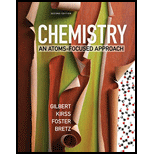
To find:
The chemical and net ionic equation in each case
Also identify the Bronsted-Lowry acid and base from a) to d)
Answer to Problem 15.110QA
Solution:
a) Chemical equation:
Net ionic equation:
acid =
b) Chemical equation:
Net ionic equation:
acid =
c) Chemical equation:
Net ionic equation:
Acid =
d) Chemical equation:
Net ionic equation:
Acid =
Explanation of Solution
1) Concept :
Chemical equation is the symbolic representation of a
The net ionic equation is a chemical equation that shows only the soluble and strong electrolytes reacting (ions) and omits the spectator ions which remain unchanged during the reaction.
According to Bronsted –Lowry acid base theory, acids are proton donors whereas bases are proton acceptors.
a) Chemical equation:
This above chemical equation can be written as:
So the net ionic equation is:
b) Chemical equation:
This above chemical equation can be written as:
So the net ionic equation is:
OH- ion is produced from the ionization of
c) Chemical equation:
This above chemical equation can be written as:
So the net ionic equation is:
d) Chemical equation:
This above chemical equation can be written as:
So the net ionic equation is:
OH- ion is produced from the ionization of
Conclusion:
The molecular equations are the balanced equations with reactants and products.
The net ionic reaction equation is the equation that is left behind after cancelling out the spectator ions for both sides.
Want to see more full solutions like this?
Chapter 15 Solutions
Chemistry: An Atoms-Focused Approach (Second Edition)
 ChemistryChemistryISBN:9781305957404Author:Steven S. Zumdahl, Susan A. Zumdahl, Donald J. DeCostePublisher:Cengage Learning
ChemistryChemistryISBN:9781305957404Author:Steven S. Zumdahl, Susan A. Zumdahl, Donald J. DeCostePublisher:Cengage Learning ChemistryChemistryISBN:9781259911156Author:Raymond Chang Dr., Jason Overby ProfessorPublisher:McGraw-Hill Education
ChemistryChemistryISBN:9781259911156Author:Raymond Chang Dr., Jason Overby ProfessorPublisher:McGraw-Hill Education Principles of Instrumental AnalysisChemistryISBN:9781305577213Author:Douglas A. Skoog, F. James Holler, Stanley R. CrouchPublisher:Cengage Learning
Principles of Instrumental AnalysisChemistryISBN:9781305577213Author:Douglas A. Skoog, F. James Holler, Stanley R. CrouchPublisher:Cengage Learning Organic ChemistryChemistryISBN:9780078021558Author:Janice Gorzynski Smith Dr.Publisher:McGraw-Hill Education
Organic ChemistryChemistryISBN:9780078021558Author:Janice Gorzynski Smith Dr.Publisher:McGraw-Hill Education Chemistry: Principles and ReactionsChemistryISBN:9781305079373Author:William L. Masterton, Cecile N. HurleyPublisher:Cengage Learning
Chemistry: Principles and ReactionsChemistryISBN:9781305079373Author:William L. Masterton, Cecile N. HurleyPublisher:Cengage Learning Elementary Principles of Chemical Processes, Bind...ChemistryISBN:9781118431221Author:Richard M. Felder, Ronald W. Rousseau, Lisa G. BullardPublisher:WILEY
Elementary Principles of Chemical Processes, Bind...ChemistryISBN:9781118431221Author:Richard M. Felder, Ronald W. Rousseau, Lisa G. BullardPublisher:WILEY





